THE TEST PILOT'S TEST PILOT
Frederick Trapnell, Patuxent River, Circa 1947-49 (Source: Allen Airways)
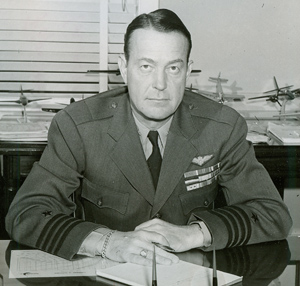 |
Frederick Mackay Trapnell was born on July 9, 1902, in Elizabeth, New Jersey. His parents were Benjamin Trapnell and Ada (Probasco) Trapnell. He attended Pingry School and Stevens Preparatory School. As a youngster he displayed a natural grasp of mechanical engineering and an affinity for ships and the sea that endured throughout his life.
He received an appointment to the U.S. Naval Academy, Annapolis, Maryland, from the State of West Virginia in 1919. After graduating, and after serving the required two years at sea, he applied for naval aviation. He was subsequently designated Naval Aviator in March, 1927 (additional details below).
From then until December, 1943 he served in continuous flying duty in either operational squadrons or the Navy Flight Test Section. In fact, within three years of becoming an aviator, his unusual abilities were recognized by his assignment to the Flight Test Section at NAS Anacostia in 1930.
F.M. Trapnell Hair Lock, August 4, 1905
(Source: Allen Airways)
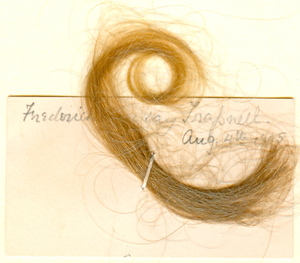 |
We are fortunate to have a fairly complete document and photographic record of Trapnell's early life and military career. This record is shared with us by his nephew, Willis Allen of El Cajon, CA (cited, right sidebar). The record includes letters, certificates, photographs, drawings and log books. The collection even includes, at left, a lock of Trapnell's hair, clipped when he was three years old. This is the only incidence of an artifact of this type that I've seen for a Register pilot.
Here is his graduation certificate from primary school, dated June 28, 1912 when he would have been nearly ten years old.
F.M. Trapnell, Primary School Graduation Certificate, June 28, 1912
(Source: Allen Airways)
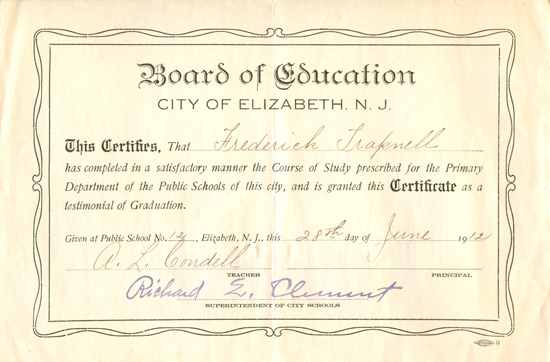 |
Below, his1919 letter of recommendation for the Naval Academy. It was forwarded by Senator Howard Sutherland of West Virginia.
Trapnell's Nomination for the Naval Academy, March 7, 1919
(Source: Allen Airways)
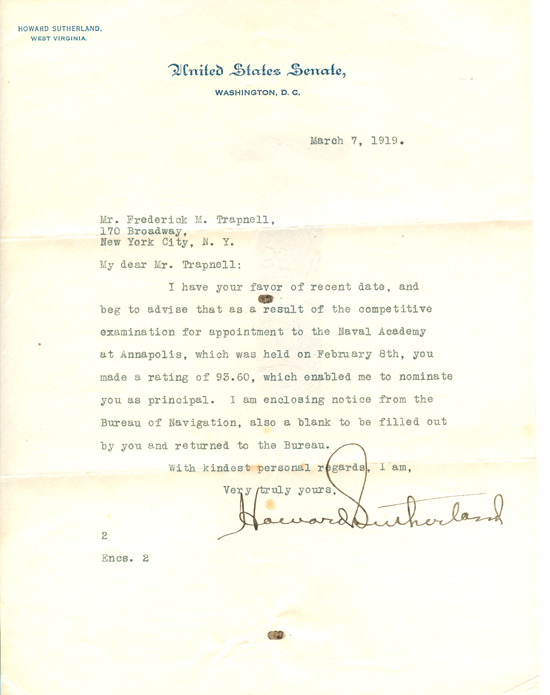 |
He was graduated from the Naval Academy and commissioned Ensign on June 7, 1923. He subsequently advanced in rank, attaining that of Rear Admiral, January 1, 1951. On October 1, 1952, he was transferred to the Retired List of the U.S. Navy and was advanced to the rank of Vice Admiral on the basis of combat awards.
Immediately after graduation from the Academy, he joined the U.S.S. California and served on that battleship, the flagship of Commander Battle Fleet, until June 1924. In January 1926, he returned to the United States for flight training at the Naval Air Station, Pensacola, FL.
Below, his graduating class from flight school at Pensacola. He sits at the center of the middle row with his arms crossed.
F.M. Trapnell, Center of Middle Row, March 22, 1927
(Source: Allen Airways)
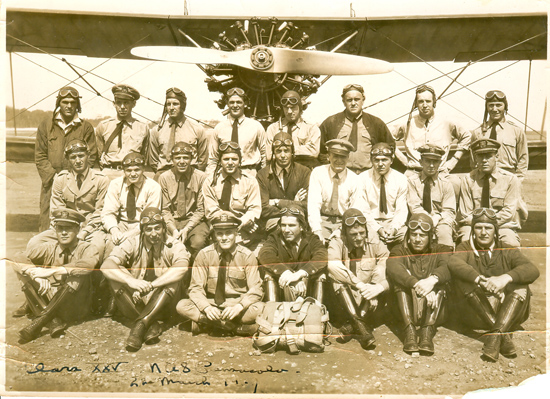 |
Below, the caption on the back of the photo above. None of the others but Register pilot H.R. Bogusch, bottom row, right, can be positively identified in the Register database.
F.M. Trapnell, Center of Middle Row, March 22, 1927, Caption
(Source: Allen Airways)
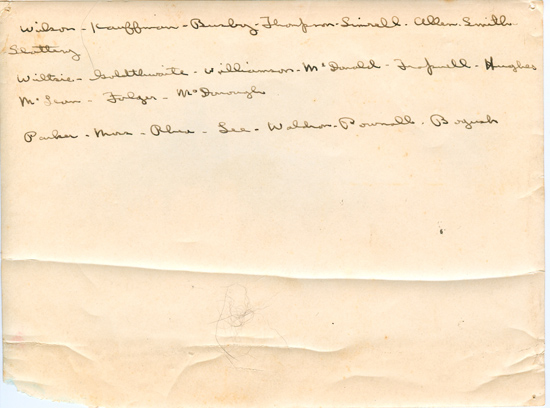 |
Designated Naval Aviator on March 25, 1927, he remained at the Pensacola Air Station until July of that year, when he was assigned to Torpedo Squadron ONE-S (redesignated Torpedo Squadron ONE-B) attached to the Fleet Air Base, Norfolk, Virginia, and later operating with Aircraft Squadrons, Battle Fleet. In March 1928 he joined Fighting Squadron FIVE.
Below, his designation as Naval Aviator.
March 25, 1927, Naval Aviator Designation
(Source: Allen Airways)
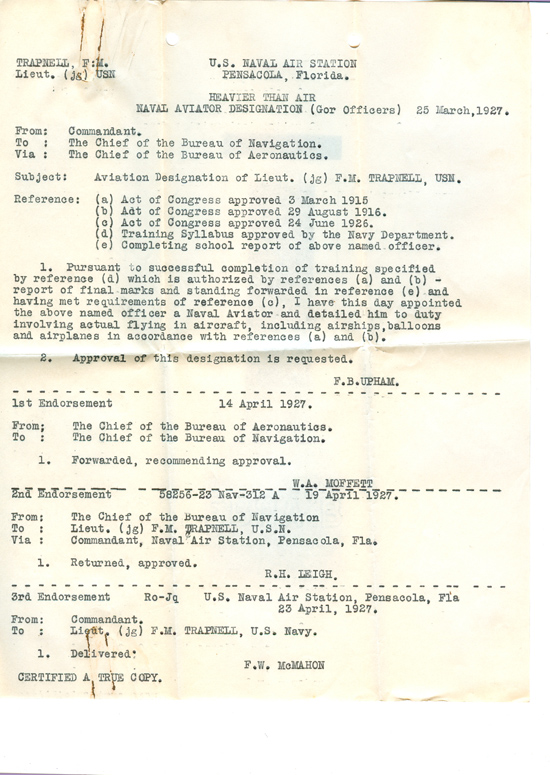 |
Shortly, he moved to San Diego, CA aboard the aircraft carrier U.S.S. Lexington. Immediately below are images from April 6, 1928. The first one is of Trapnell executing a takeoff from the Lexington near San Diego. Although both the Lexington and Saratoga had flywheel-driven catapults, it looks like this takeoff was performed without aid of the catapult.
U.S.S. Lexington Departure, April 6, 1928
(Source: Allen Airways)
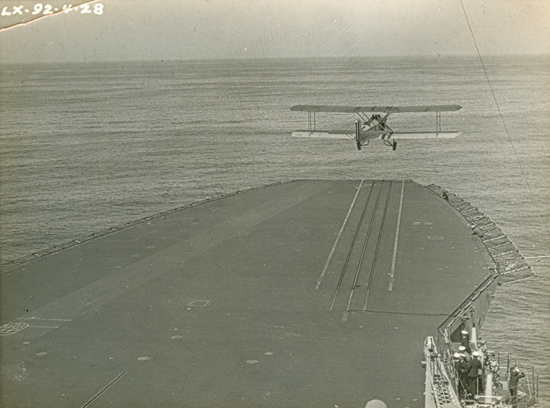 |
Below, the caption, enhanced in PhotoShop for easier readibility.
U.S.S. Lexington Departure, April 6, 1928, Caption
(Source: Allen Airways)
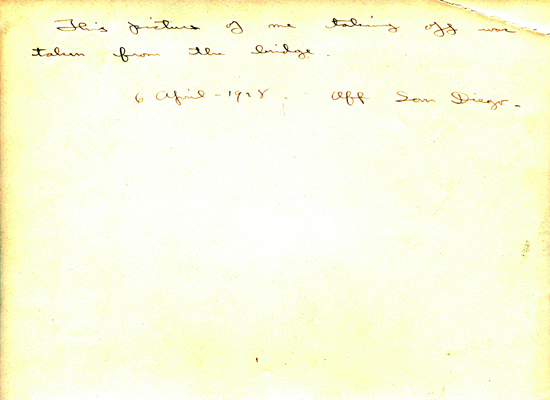 |
Below, the page from his flight log book that records his sortie off the Lexington. He flew a Martin T3M-2, A-7229 (not a Register airplane). The "A" designation for the "Character of Flight" means the flight was for training and instruction (for students, see the key farther below). In the original photo you can see a passenger in the rear cockpit.
Flight Log, U.S.S. Lexington Departure, April 6, 1928
(Source: Allen Airways)
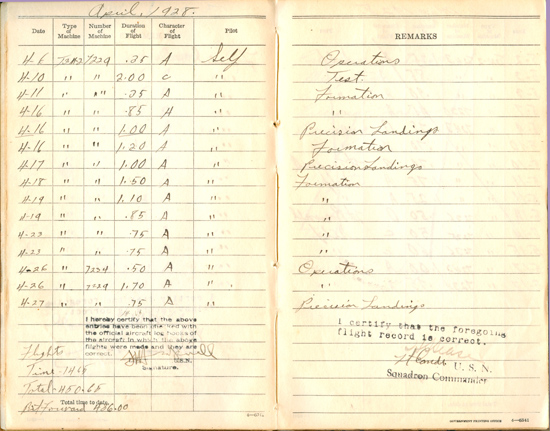 |
Below, a portrait of the April 6th flight officers on board the Lexington. Note the life vests on most of them. Trapnell is partially hidden, 3rd from left. The large, blocky Martin T3M-2 rests behind them. Another photo of the type (sister ship A-7305) is here, shown on floats.
Informal Portrait, Flight Crew on Board U.S.S. Lexington, April 6, 1928
(Source: Allen Airways)
 |
Below, the caption on the back of the photo above. There is a Register pilot E.C. Parker who was a Navy pilot. It can't be determined, however, if he is the same as the pilot second from right in the photo above. None of the other names match the Register database.
Informal Portrait, Flight Crew on Board U.S.S. Lexington, April 6, 1928, Caption
(Source: Allen Airways)
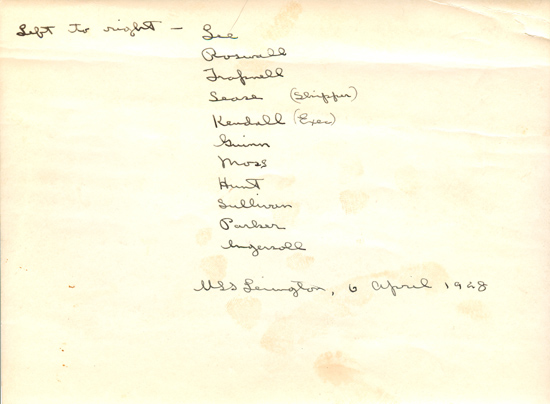 |
Now comes Trapnell to Tucson. Navy lieutenant Trapnell signed the Davis-Monthan Airfield Register once on Thursday, June 27, 1929 at 1:00 PM. Based at San Diego, CA, he arrived solo in Boeing F3B A-7753. Joe Baugher's site identifies it from the series A-7708 to A-7763 as a Boeing F3B-1 in the S/N range 955-1010 (does anyone KNOW anything else about his airplane?). He was with a group of at least six other Navy pilots flying various models of F3Bs. They stayed on the ground until 2:30 PM and headed back west. See his flight log book entry for this flight, further below.
About five months later he had the opportunity to join a select group of aviators in the Caterpillar Club. The airplane he was flying burst into flames, forcing his exit via parachute. Jumping from a disabled aircraft, and floating to Earth with the ripcord D-ring intact, qualifies one for the Club. He made a second emergency jump in February, 1932, which is documented in a news article below.
F.M. Trapnell, Right, Inducted into the Caterpillar Club, November 16, 1929
(Source: Allen Airways)
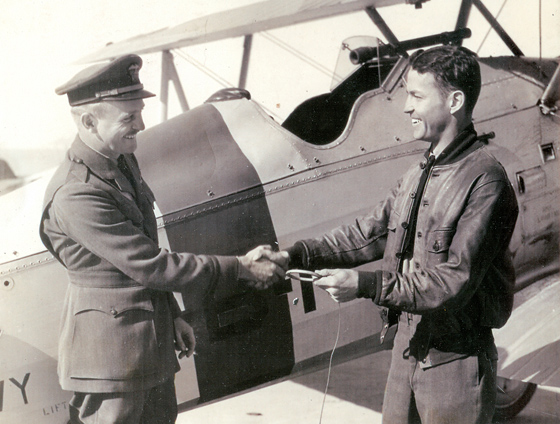 |
Below, the news slug on the back of the photograph. The slug mentions the "Three Sea Hawks". Below on this page are pictured two charter members of that group: A.P. "Putt" Storrs and William V. Davis, Jr. (the other charter member was Register pilot D.W. "Tommy" Tomlinson). Note the difference in the names of flight team members between this slug and the one for the second image below. Either the composition of the team changed between November 16, 1929 and October 24, 1930, or the news media got the names wrong.
F.M. Trapnell, Right, Inducted into the Caterpillar Club, November 16, 1929, Caption
(Source: Allen Airways)
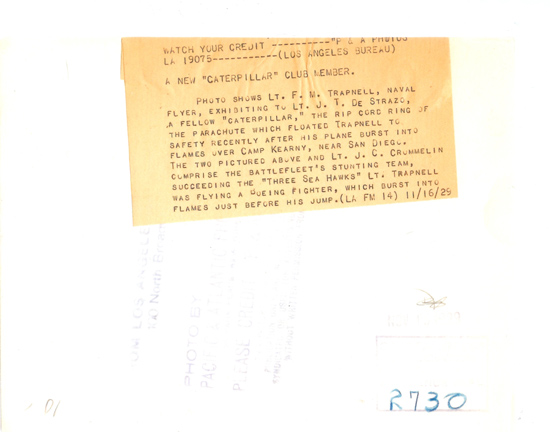 |
Shortly after we find him parachuting, he was assigned shore duty, in January 1930, in the Flight Test Section at the Naval Air Station, Anacostia, DC. Below, a portrait of him while assigned to Anacostia.
F.M. Trapnell, Anacostia, 1930
(Source: Allen Airways)
 |
F.M. Trapnell, Anacostia, 1930, Caption
(Source: Allen Airways)
 |
According to his official biography, during this period he also was a member of the acrobatic team known as the "Three Flying Fish" which appeared at various air races under the auspices of the Bureau of Aeronautics. Below, an image of the three flyers that made up the team.
Trapnell (R) And Flight Team, October 24, 1930
(Source: Allen Airways)
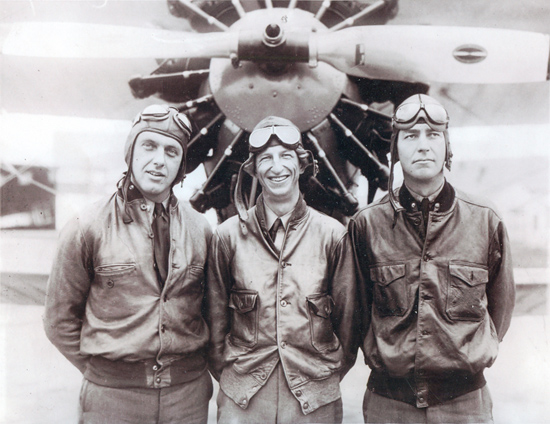 |
Note, however, the news slug on the back of the photograph identifies the team name as, "The Three Musketeers of the Air" and "Three Musketeers of the Navy". Regardless of the name, notice the nicely-conditioned A-1 jackets.
Trapnell (R) And Flight Team, October 24, 1930, Annotation (Source: Allen Airways)
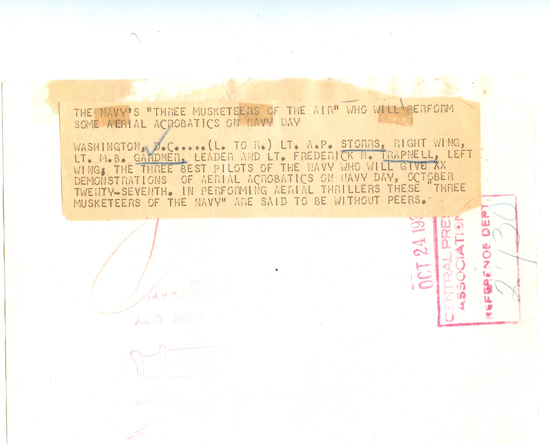 |
Below, courtesy of site visitor Steve Carle, a contemporary, undated news article describing the formation of the "Three Flying Fish." Compare the individual photographs with the one above. Interestingly, A.P. "Putt" Storrs had served earlier as a member of the Navy acrobatic team "The Three Sea Hawks," known for their takeoffs, aerobatic flights and landings while tethered together at the wingtips by ropes.
Undated & Unsourced News Article, "Three Flying Fish," Ca. 1930 (Source: Carle)
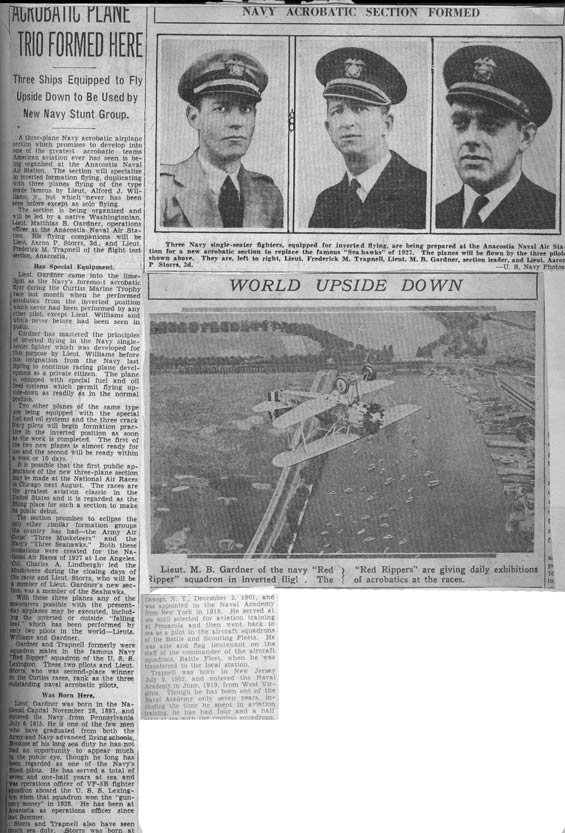 |
The following article by journalist Ernie Pyle documents the "Three Flying Fish" during their first demonstration flight. It also connects site contributor Carle to the subject. His grandfather, mentioned at the bottom of the first column, produced the flying fish stencil that was used to paint that insignia on the tails of Trapnell et al's vertical stabilizers. Interestingly, the article also cites an example of early military censorship that probably wouldn't be tolerated by the press today. It's fairly clear that Pyle bit his tongue in the last paragraph.
Undated & Unsourced News Article by Ernie Pyle, "Three Flying Fish," Ca. 1930 (Source: Carle)
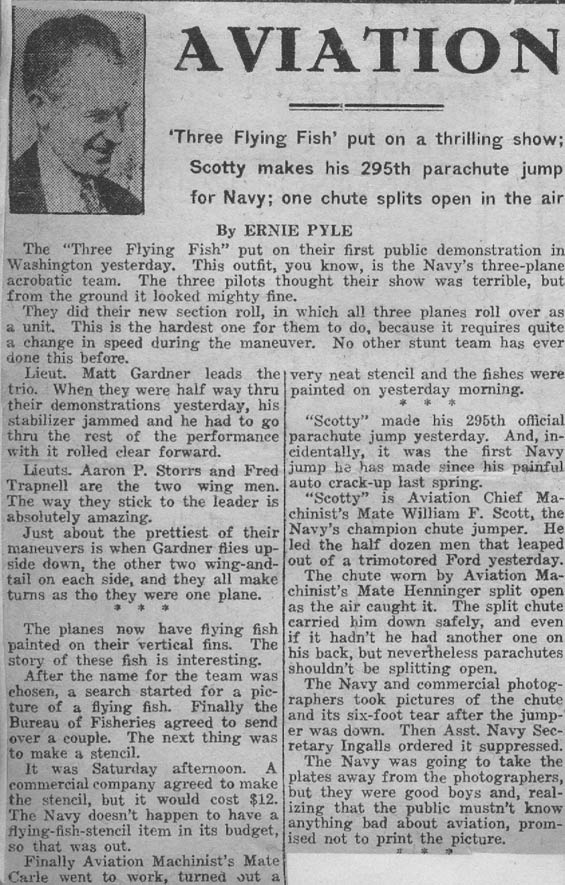 |
On February 26, 1932, the following article appeared, again authored by Ernie Pyle, in the Washington (DC) Daily News. The story interweaves a lost dog, "Wally," with a parachute escape by Trapnell from a disabled Navy airplane.
Washington (DC) Daily News, February 26, 1932 (Source: Carle)
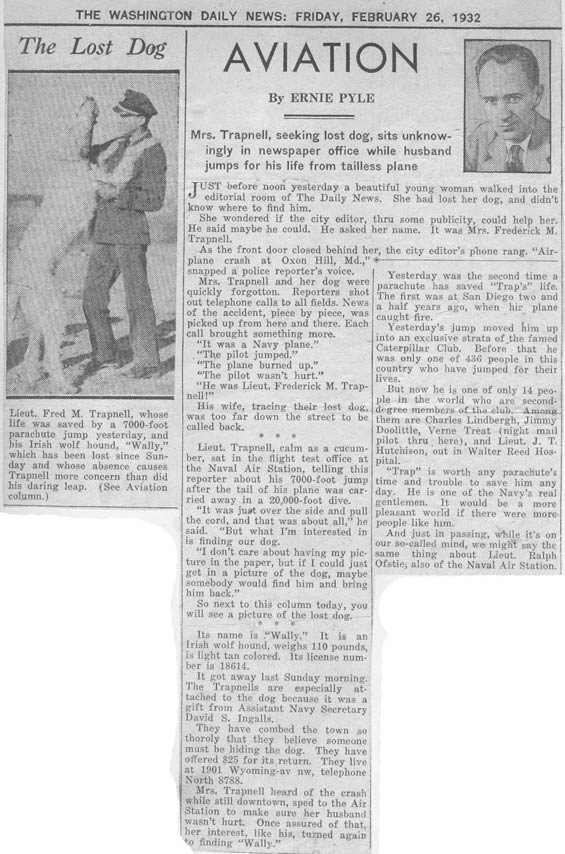 |
Next, in June 1932, Trapnell was assigned to the U.S.S. Akron, the first of the Navy's two large, airplane-carrying dirigibles, as a member of the airplane unit. Following the loss of the Akron, he transferred to her newer sister ship, the U.S.S. Macon, and remained with her until June 1934 in charge of her airplane group . While on the Macon he received a Letter of Commendation from the Chief of the Bureau of Aeronautics for the development of gear and methods for airplane hook-on to dirigibles.
Below, a photograph of the Macon heavily signed by naval officers. Given the appearance of that sky, we hope the Macon was firmly tethered.
Dirigible U.S.S. Macon, Miami, FL, 1934
(Source: Allen Airways)
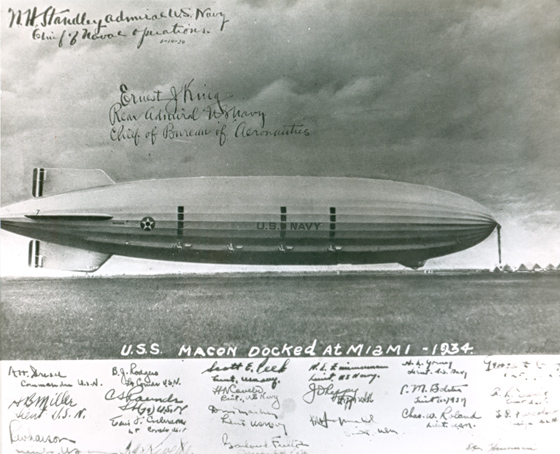 |
This leads us to an interesting chapter in Trapnell's flying life, that of landing, or actually hooking, Golden Age fighter aircraft to moving, rigid airships. Although Register naval pilot A.W. Gorton was credited with the first such hookup, Trapnell perfected the skill and trained many in the art. His flight logs for 1932-34 are full of such hookups and departures. Several makes and models of aircraft were tried by the Navy: Curtiss, Fleet and Vought.
For example, below, two images, dated February 9, 1934 from Mr. Allen's collection, illustrate the procedure. The first image shows the inside of the dirigible and its structure at the top of the image. The trapeze apparatus is shown above the airplane, and the "hook" is hidden behind the foreground pulley and just out of the top of the image. The structure supporting the hook is attached to the airplane. The bar coming in from the upper left guides the hook to the dirigible-based trapeze.
Consolidated N2Y-1 Hookup to U.S.S. Macon, February 9, 1934
(Source: Allen Airways)
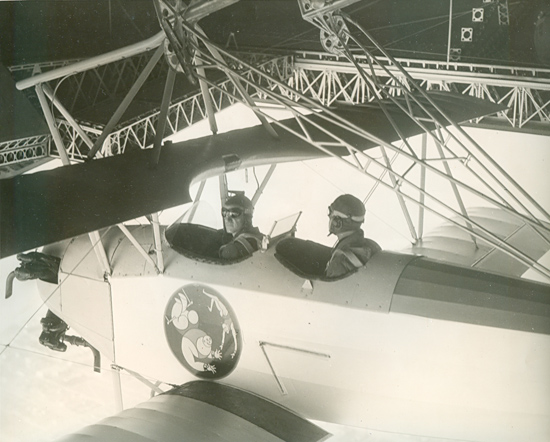 |
Notice the trapeze handoff cartoon logo on the side of the fuselage. Trapnell's son says of this image, "I do not recognize the man in the front cockpit, so I am pretty sure it is not my father. ... However, it does show the trapeze and hoist that he designed and that replaced the original. His design was much lighter, easier to operate, and gave better stability to the aircraft. ... While I cannot be sure, the man in the rear cockpit could be him - he has the right posture and silhouette."
The pilot in the front cockpit is Emile Choureé, whose logbook for February 1, 1934 documents this flight with Trapnell, who, with high probability, is the pilot in the rear cockpit. Please review Choureé's biography page and his Photograph and Document Collection for more information, including his logbooks which document this flight.
Below, the caption for the photo above.
Fleet N2Y-1 Hookup to U.S.S. Macon, February 9, 1934, Caption
(Source: Allen Airways)
 |
Below, a view of the Consolidated N2Y-1 after a recent hookup, or in preparation for a release. Note the padded yoke supporting the rear of the fuselage.
Consolidated N2Y-1 Hookup to U.S.S. Macon, February 9, 1934
(Source: Allen Airways)
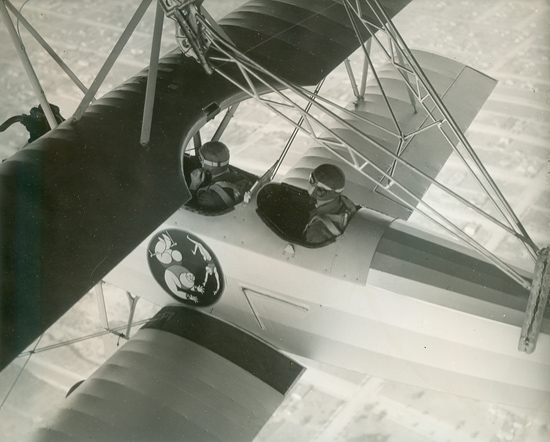 |
Below, from his 1934 flight log, this entire page documents flights to and from the dirigible U.S.S. Macon. His airplane, A-8603 (not a Register airplane), is cited at aerofiles.com, where there is a couple of images of the Fleet N2Y-1 type. There were 18 flights logged to and from the Macon and San Diego on February 9th. Chances are good, that among the passengers named in his log, is the person sitting in one of the cockpits above. The "M" desgnates "transportation of personnel" (see below for "Character of Flight" definitions). One of the people cited is "Lt. Choureé." A similar photograph, as well as the page in Choureé's log book that records his flight, is at The Emile Choureé Photograph and Document Collection at the link. What a spectacle it must have been for people on the ground looking up at the giant Macon as Trapnell and company attached and detached from the lumbering ship.
Frederick Trapnell Flight Log, February 8-10, 1934
(Source: Allen Airways)
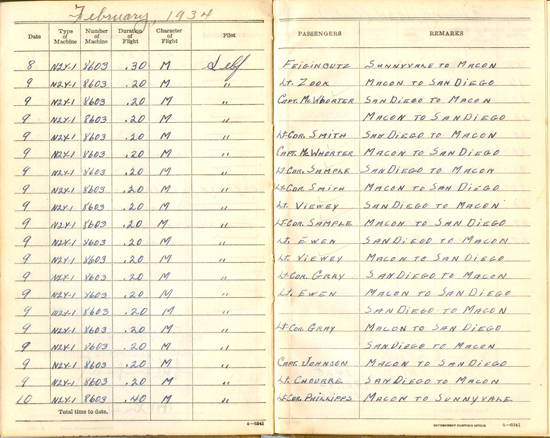 |
These two final images from Mr. Allen's collection of airplane-to-dirigible hookups are undated. The first is probably representative of the earliest trials. The airplane below is a Vought UO-1. A similar photograph is on aerofiles.com. The trapeze on the dirigible and the hook apparatus on the airplane are shown to good advantage.
Vought UO-1, Ca. 1929
(Source: Allen Airways)
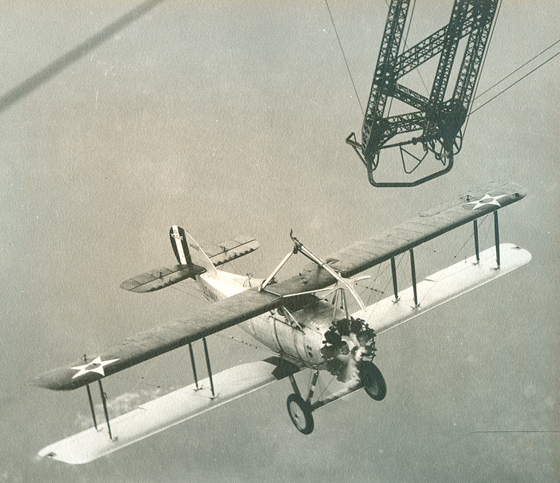 |
---o0o---
A DIGRESSION: There is a motion picture directed by Frank Capra made in 1931 entitled "Dirigible". It stars Jack Holt, Ralph Graves and Fay Wray, and, according to markings on the aircraft, it was filmed with aircraft based at NAS Anacostia.
Without getting into the story line, for us the important feature of this film is a dramatic few minutes of footage that documents the approach, capture and release of a biplane from the USS Los Angeles. The airplane is a Vought craft, like the one above, which would be in agreement with the date of the film.
At the link above, after some Hollywood-inspired stunting by the nonchalant pilot, we see the movie airplane approach the "trapeze" on the bottom of the airship, maneuver into position, then hook onto and lock the capture bracket. As the airplane approaches the trapeze in the film, note the rudder, elevator and aileron control movements exerted by the pilot, and the stack of cameras just forward of the vertical stabilizer. As the camera angle switches to behind the pilot, you understand exactly from where the camera was aimed. After shouted congratulations by the airship commander for the successful hook, the pilot pulls the release handle and the mechanism on his airplane disengages from the trapeze and he falls away.
About the movie, the Wynne reference on page 108 states, "With the cooperation of the U.S. Navy, Columbia made 'Dirigible' in 1930 [it was released in 1931], a very realistic film that featured the giant rigid airship 'Los Angeles.' While some miniatures were utilized for a crash scene, much of the air action was photographed at the Navy's Lighter Than Air Base in Lakehurst, New Jersey." The cinamatographer for the film was Elmer Dyer, famous for his aerial films of the 20s and 30s, including "Hell's Angels". Dyer is cited in numerous places in the Wynne reference.
If you're like me, this film sequence is worth replaying a few times using the stop action and rewind controls to analyze this early experiment with docking fighters to rigid airships. Alas, the days of the rigid airships were numbered. But that's another story.
---o0o---
To continue, in this next image, the airplanes are Curtis [sic] Sparrowhawks. The original photo was on card stock and appeared to be a souvenir image. The airship is the U.S.S. Macon.
Curtiss Sparrowhawks Hooking to the U.S.S. Macon, Date Unidentified
(Source: Allen Airways)
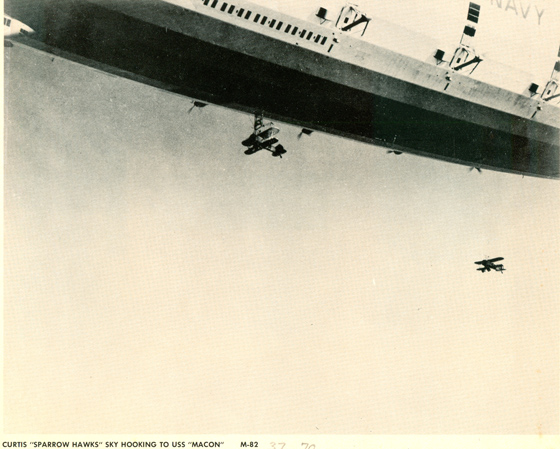 |
Speaking of flight logs, Trapnell left us ten military-issued flight logs. Book #1 covers 1926-27; Book #2 covers January 1928 -August 1929; Book #3 September 1929-June 1931; Book #4 July 1931-August 1933; Book #5 September 1933-August 1935, etc. Below, the cover of the second volume.
Frederick Trapnell Flight Log, January, 1928 to August, 1929
(Source: Allen Airways)
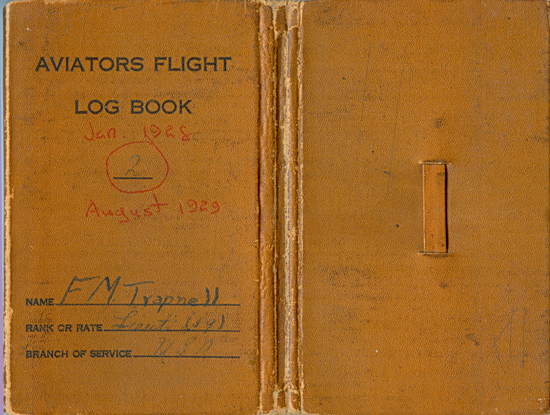 |
On January 20, 1952 he flew his last flight at Albuquerque, NM for two hours in an F7F-3, BuNo 80409. His last book ends January 22, 1952, when, after logging 6,276.7 total flight hours, he entered simply, "Grounded". No reason was given by him in his log, but he had earlier suffered a heart attack and was judged not qualified to fly.
In happier times, according to Trapnell's pilot log #2, below, on June 27, 1929 the group he accompanied to Tucson was on a round-robin flight from San Diego back to San Diego, probably for cross-country training.
F.M. Trapnell's Pilot Log Book, June 1929
(Source: Allen Airways)
 |
Interestingly, a discrepancy shows up in the logging of his airplane identification number. He clearly writes in the Register "A-7753". However, his Tucson airplane is clearly identified as "A-7754" in his personal log. Mr. Allen (cited in right sidebar) states that he, "...could only find that he flew 7753 once between 1928 - June of 1931. The latter dates were when he was flying back East and doing some airship work."
It could be that this busy pilot, faced with a day of flying that covered 8.9 hours in the air, simply jotted down the wrong number in the Register. Notice that he flew the same airplane on a test the next day, and on a cross-country ("C.C.") flight to San Francisco, CA and back on June 29-30.
Additionally, he had flown this same airplane in a fleet exercise in February, 1929 as documented in his log, below.
Fleet Exercise Recorded in Trapnell's Flight Log, February, 1929
(Source: Allen Airways)
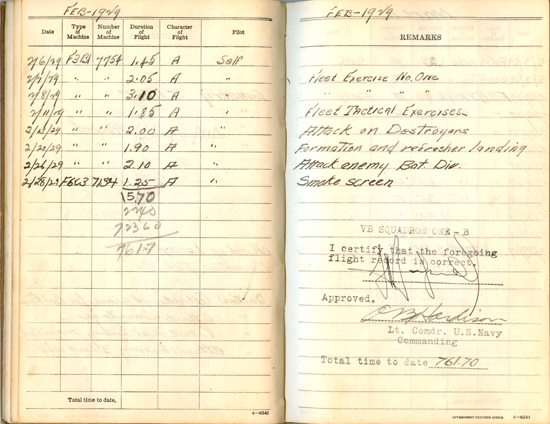 |
Note mention of the "smoke screen". There is another incidence of a smoke screen used during an aerial exercise, albeit in the Hudson River. To read about it, and see an image, please visit Roland Birnn's page.
For comparison, this image is of the Boeing F3B-1, registration A-7763 (not a Register airplane). It is of the same Bureau Number series, and similar to the ships flown by the seven Navy pilots who landed at Tucson on June 27th.
What about the "Character of Flight" column? The"C", "D", "E" and "H" stand for the "Character of Flight" of his sorties as summarized in this table, below, from his 1942 log. Curiously, he noted that his flight to Tucson, up above, was "H", a cross-country torpedo run!
"Character of Flight" Codes
(Source: Allen Airways)
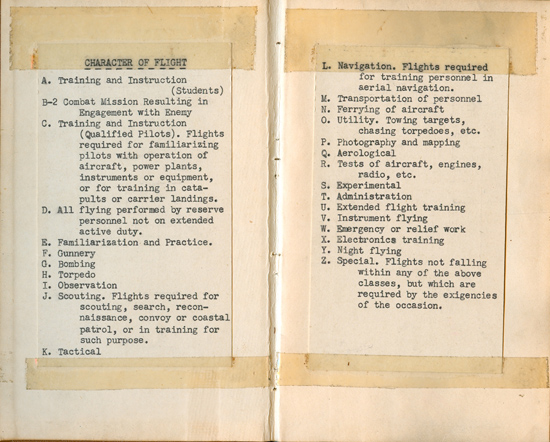 |
To continue with a rough chronology of his career, from May 1940, until late 1943, he was again at Anacostia, this time as Head of the Flight Test Section. The imminence of WWII created a pressing need for major improvements in fleet aircraft. New developments in engines, aircraft construction and aerodynamics made this possible, but also led to larger, heavier, and more complex airplanes that were potentially more of a handful to fly. To cope with this, Trapnell expanded the Navy's test procedures to incorporate examination of every factor that could affect an airplane's capability. Thus, he was instrumental in the development of flight-test methods and procedures which came into general use in the Navy.
Another way of saying this is that a test pilot had to combine flying skill with engineering knowledge, qualities which he possessed naturally. He set out to train his pilots to improve their flying skills as well as their technical understanding of aircraft aerodynamics, structures, and operational requirements.
Just prior to WWII, Trapnell was instrumental in selecting and developing two high-performance fighters which bore the brunt of Pacific battles. In 1940, and 1941, he and his unit evaluated a number of newly designed prototype aircraft, as well as modified versions of U. S. Army and British fighters.
From this emerged one aircraft which had the potential to meet Navy requirements for a high-performance fighter, the Vought XF4U Corsair. Trapnell personally spent months in flight-test evaluation of this plane and its numerous modifications. A number of troubles and shortcomings were unearthed, and feedback to the Vought engineers produced extensive modifications to the fuselage, wings and ailerons. Below, a view of the end of one test flight of the XF4U. Although the landing wheels were nicely pranged, the propeller was in good shape. Trapnell's son states about this photograph it, "... is actually a taxiing accident. The landing gear handle in this XF4U had no safety cover or other protection of any kind. Thinking he was raising the flaps, my father accidentally raised the landing gear while taxiing (at Anacostia, I think). The '100% pilot error' comment on the back of the photo expresses his chagrin."
Corsair Taxi Accident, 1942
(Source: Allen Airways)
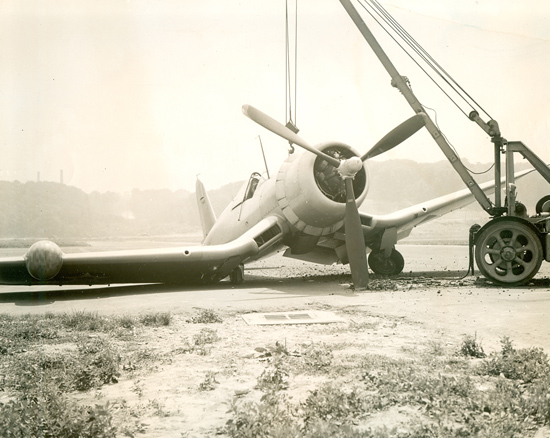 |
Below, the caption for this photograph. Blame was frankly placed where blame was due. Eventually, the revised version of the Corsair went into production in late 1941. Over ten thousand were built; it served as a first-line Navy aircraft until the end of the Korean War.
Corsair Hard Landing, 1942, Caption
(Source: Allen Airways)
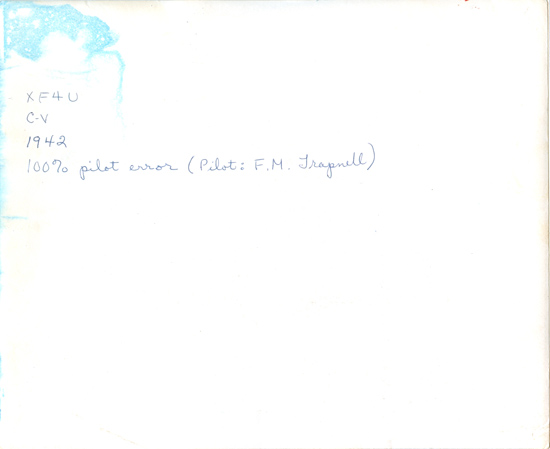 |
Several other Register signers were renowned test pilots. Please direct your browser to Tony LeVier and review his summary of incidents throughout his life of flight testing. See also E.E. Harmon, Hub Fahy, Milo Burcham, Dick Ranaldi and C.E. Clark, among others.
Trapnell's abilities as a test pilot brought him a reputation not only in the Navy but in the United States aircraft industry. Upon entering WWII it was soon evident that the Japanese Zero fighter was superior to any U.S. operational aircraft (the Corsair did not go into combat until early 1943). In view of this, the Grumman Engineering Company launched a crash program to produce another high-performance fighter for the Navy to supplement the Corsair. The prototype F6F Hellcat was ready for test flying in mid-1942. With a desperate need to shortcut the normal six-to-eight-month Navy test cycle, Grumman asked the Navy to allow Trapnell to personally evaluate the plane.
Roy Grumman's comments on this are revealing: "He came to the factory and flew the prototype F6F. It suited him, as I remember, except for the longitudinal stability--he wanted more of that. We built it in, and rushed into production without a Navy certificate on the model--we relied on Trapnell's opinion. His test flight took less than three hours. I'm not sure that we ever got an official O.K. on the Hellcat design. I think it finally came through after V-J Day. By that time Hellcats had shot down 5,155 Jap planes--and that's over half of the Navy's total bag for the war."
With the onset of WWII, there was neither ground space nor airspace at Anacostia to meet the flight testing load of the Navy. In September, 1942, Trapnell and the Flight Test Unit moved to newly-established Naval Air Station, Patuxent River to originate what is today the Naval Air Test Center.
In early 1943, Trapnell was detached for a brief period to the Army Air Force's then secret-test field at Muroc Dry Lake, now Edwards AFB. There, he flew and evaluated the new Army XP-59A Aerocomet, the first U. S. jet-propelled aircraft manufactured by Bell. This testing served as a precursor to his later contributions to jet-aircraft testing and made him the Navy's first jet pilot.
For his work as Head of the Flight Test Section, he received a letter of commendation for outstanding performance of a "very hazardous and difficult assignment" from Secretary of the Navy, Frank Knox. In part, it reads, "Under your guidance, the test section changed its nature from that of an acceptance group to determine suitability for service to that of a semi-development group assisting in the elimination of flight deficiencies in the early stages of flight tests, finally passing on the acceptance of the delivered airplane for service use."
Trapnell was promoted to Captain and left Anacostia for fleet duty in mid-1943. He briefly commanded Fleet Air Wings Four and Fourteen, then in December 1943, took command of the escort carrier Breton. He held this command until October, 1944, when he became Chief of Staff to Commander Carrier Division Six. He was awarded the Bronze Star for services while commanding the Breton and the Legion of Merit with Combat V for his staff duty.
He was always conscious of the importance of all-weather flying, and developed his personal skills in blind flying and navigation to a high state long before the advent of instrument aids. Formal instrument flying rules and licenses were introduced in the United States just after the war. At that time, he became one of the first U. S. pilots to be given a "green ticket" form of the license. Below, a cartoon "certificate" signifying completion of instruction in a ground-based instrument teaching device known as the "Link Trainer".
Link Trainer Certificate, February 8, 1940
(Source: Allen Airways)
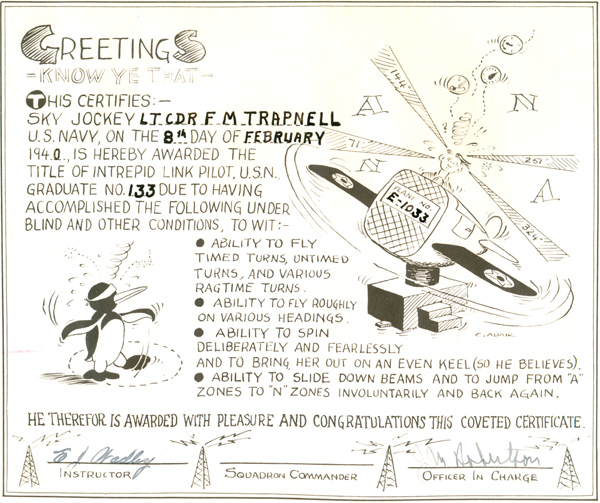 |
In June of 1946, Trapnell returned to Patuxent River. By this time the role of aircraft testing had expanded from a Flight Test Section to a series of test divisions: Armament Test, Electronic Test, Flight Test, Service Test, and Tactical Test. Patuxent River was officially known as the Naval Air Test Center. Trapnell was made Test Center Coordinator over all test divisions. The diversity of activities at Patuxent reflected the realization that Navy airplanes had to demonstrate a broad range of capabilities. The sheer size of the operation (a $100 million installation) reflected the Navy's conviction that the way to produce good airplanes was to provide manufacturers with thorough and professional evaluation of their product in all facets of the Navy environment. The Navy was on the verge of a technological revolution. Trapnell was chosen to orchestrate their role in it. Below, Trapnell (L) takes command from Register signer Apollo Soucek.
F.M. Trapnell and Apollo Soucek, August 11, 1947
(Source: Allen Airways)
 |
Dated caption, below.
F.M. Trapnell and Apollo Soucek, August 11, 1947, Caption
(Source: Allen Airways)
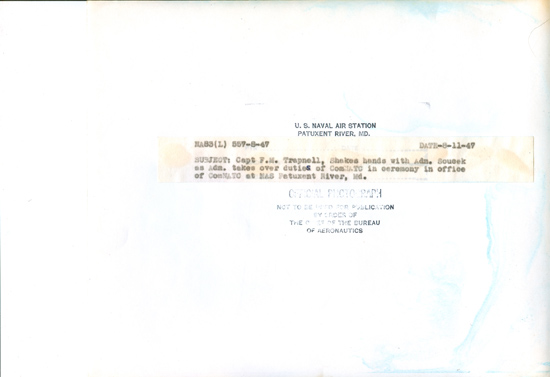 |
Jet propulsion promised aircraft performance beyond anyone's prior dreams. But, both the jet engine's characteristics and the performance it promised raised a host of problems. For example, jet engine fuel consumption was ten times as great as that of the piston engines then in use; both the emergency thrust at low speeds and the rate at which that thrust could be changed by the pilot were much less than what was available from piston engines. And the high speeds possible with jet propulsion necessitated airplane designs which had inherently bad flying characteristics at low speeds. They were difficult to control and simply would not fly as slowly as their piston-engined counterparts.
Below, the command group at Patuxent River as of August 11, 1947. Trapnell is front, left. The officer at right, rear, a Golden Age legend himself, is William V. Davis, Jr. Davis was the navigator responsible for the successful flight of the Travel Air "Woolaroc" from Oakland, CA to Honolulu, T.H. in August, 1927. Please direct your browser to Register pilot Art Goebel's page to review the voyage of the "Woolaroc" and to learn about a book published during November, 2009 that features Davis and pilot Goebel.
PAX River Command Group, August 11, 1947
(Source: Allen Airways)
 |
Dated caption, below.
PAX River Command Group, August 11, 1947, Caption
(Source: Allen Airways)
 |
Finally, the high speeds of these aircraft meant that they were routinely approaching the speed of sound--the speed where the apparent drag of the airplane became so great that no living man had been beyond it and where, then, ill-understood forces could take control of the aircraft, frequently causing its destruction in the air.
Trapnell's assignment was to bring the resources of the Navy, and particularly the Patuxent Test Center, to bear on these problems and to work with aircraft manufacturers to produce for the Navy a useful weapon in the form of high-performance jet aircraft. According to Admiral Arleigh Burke, later Chief of Naval Operations, "He was given this assignment because he was acknowledged as being superior in the knowledge and skill required to develop new jet aircraft with unknown characteristics. It is unusual for any man to be universally acclaimed as the very best in his field, but Trapnell had the unique distinction of being known as the very best engineering test pilot there was."
Below, Trapnell stands in the front row 5th from the right. Interestingly, third from right appears to be a young John Glenn. Between Glenn and Trapnell stands Apollo Soucek. The officer in the white shirt is William V. Davis, Jr. (see above).
PAX River Personnel, Ca. 1948-49
(Source: Allen Airways)
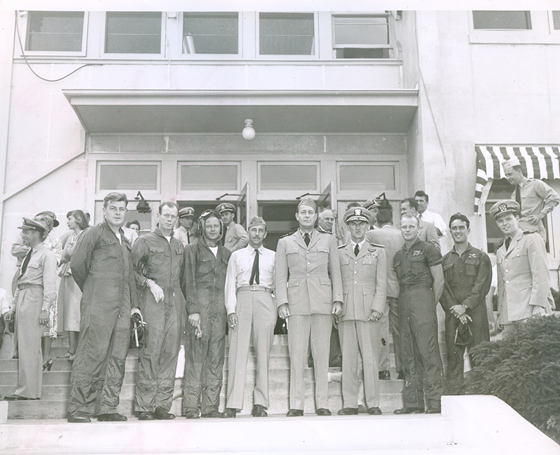 |
Below, the caption on the back of this photograph, written by Trapnell's son.
PAX River Personnel, Ca. 1948-49, Caption (Source: Allen Airways)
 |
The Test Center was blessed with many skilled professionals and a number of fine test pilots, many of whom were proteges of Trapnell. His first task was to organize this group into a testing team and to direct their activities in evaluating prototype aircraft. He quickly moved into the leadership position at Patuxent. His skill, knowledge, and character provided the example to which the officers under him would aspire. According to Major General Marion E. Carl, USMC, one of the outstanding test pilots at Patuxent: "He was admired for his knowledge of airplanes and for his abilities as a pilot, particularly as a test pilot. He was also admired for his integrity."
Trapnell was known for his insistence on accurate, clear and systematic reporting of flight characteristics. "Get the numbers" was the pilots' watchword. With the host of technical problems facing them, the need to convert test results into design criteria was no longer desirable; it was essential to progress. He continued to insist that any useful Navy airplane had to be a "whole" airplane. It had to operate well and safely over a broad range of conditions; it was not enough to be outstanding in a few characteristics.
This philosophy has since been the guideline of American carrier-aircraft designs. It became evident to Trapnell and others that the tremendous load of the Navy's test program could not be met with the test-pilot training facilities as they then existed. Furthermore, this activity attracted some of the most capable officers in the Navy and Marine Corps. They would soon be promoted and moved to other jobs. Finally, he was aware that the jet aircraft, however well designed, would bring to the Fleet a host of new problems for which then conventional pilot skills were inadequate. Not only would regular training need to be changed, but Navy test pilots had to be rotated into operational fleet assignments to enhance the general flying skills with their special ability and knowledge. For these reasons, Trapnell upgraded and expanded the U. S. Navy Test Pilot School at Patuxent River.
At his direction the curriculum was upgraded to a full-fledged post-graduate level aeronautical engineering program. This was combined with a flying, testing and reporting syllabus to round out the education of Navy test pilots. Its role was to accept outstanding pilots from the Fleet, train them in the arts, skills and technologies of jet-age test flying, and thus provide to the Test Center a continuous input of new blood to replace those who went to other duties.
For his work in leading the development of jet carrier-based aircraft, he was given the Octave Chanute award in 1949, by the Institute of Aeronautical Sciences. This award is given annually to "the pilot who has contributed most to aviation in that year."
Because of his value to the Navy in the testing role, he remained at Patuxent River from 1946 to 1950. During the first part of this tour he was Test Center Coordinator; later he was assigned as Test Center Commander--a Rear Admiral's position even though he was still a Captain. Admiral Radford, then Chief of Naval Operations, said, "We just don't know where to find another test pilot like him."
This assignment certainly suited his interests and love of flying. Testing new aircraft requires skill, sensitivity, and knowledge, but it also requires the stamina of youth. Thus, after careful consideration he was ordered to take command of the U.S.S. Coral Sea in April of 1950, at the age of 47. With some personal misgivings Trapnell left Patuxent River, even though the move was almost certainly in the best interests of his Naval career. As skipper of the Coral Sea he was instrumental in making the first successful deployment of jet aircraft aboard ship.
In February, 1951, he was promoted to Rear Admiral and assigned as Deputy Commander of Sandia Base and the Armed Forces Special Weapons Project at Albuquerque, NM. In April of 1952, he was hospitalized in Albuquerque following a heart attack. A subsequent medical examination board found that he was no longer fit for flying duty and recommended that he be retired from active service. According to Admiral Burke, "He had trained hundreds of young pilots, some of whom might approach his own capability. He was aware that some day those people would replace
him. But, it was with the greatest personal reluctance that he accepted the medical conclusions which ended his Naval and flying careers."
Fastidious to the end, below, the receipt exchanged for handing in his flight gear. Imagine the thoughts going through his mind at this time: perhaps of departing a flaming Boeing by parachute, or of a landing one late June day at Tucson a quarter century earlier.
F.M. Trapnell, Receipt for Flight Gear, April 26, 1952
(Source: Allen Airways)
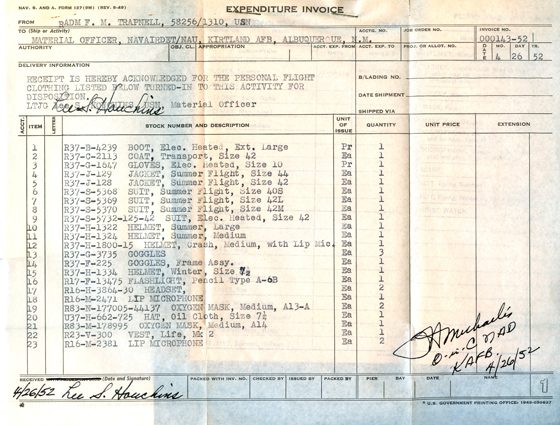 |
In September, 1952, he was transferred to the Retired List of the Navy for reasons of physical disability. In a letter, below, from Navy Secretary Dan Kimball, upon the occasion of his retirement, he was cited "as one of the outstanding pilots in the Naval service and one of the finest flight test engineers in the United States."
Letter from the Secretary of the Navy, September 16, 1952
(Source: Allen Airways)
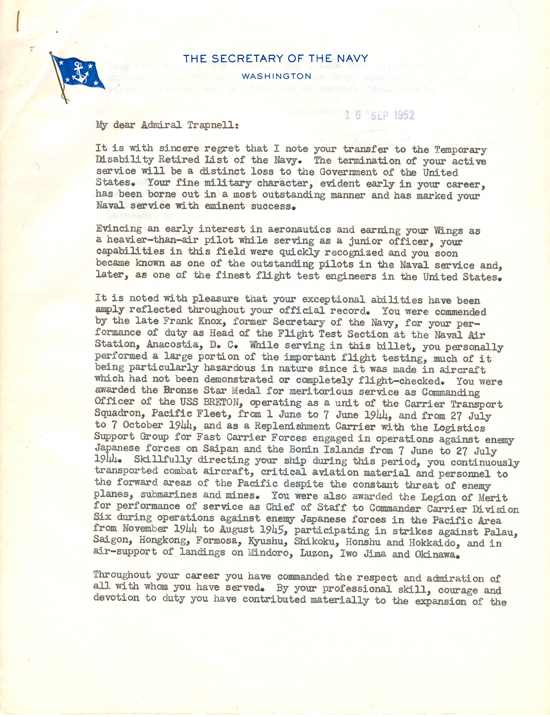 |
Second page, below.
Letter from the Secretary of the Navy, September 16, 1952
(Source: Allen Airways)
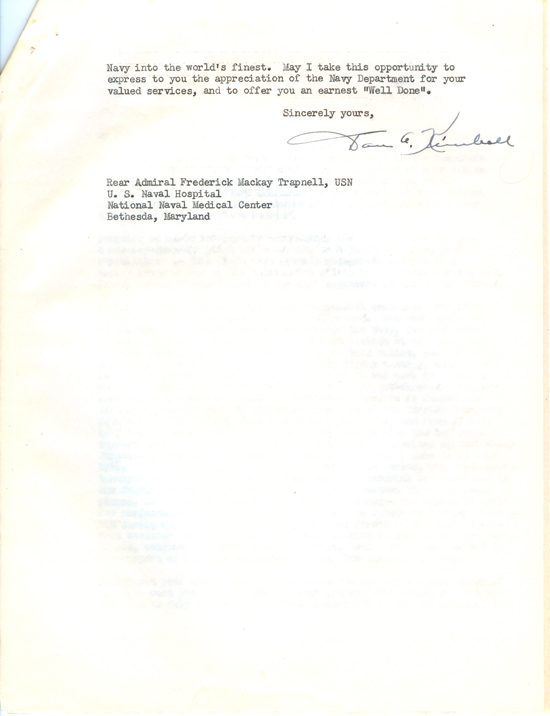 |
Subsequently, he was retained as a consultant in aeronautics and flight test operations by Grumman Aircraft Engineering Corporation.
Frederick Trapnell, whose life and contributions in aviation were equalled or surpassed only by a few other Register pilots, was also a boat designer, builder and sailor, which occupied his time for many of his post-retirement years. But that aptitude and skill is beyond the scope of this Web site. He died in the U. S. Naval Hospital, San Diego, on January 30, 1975, at the age of 72. He was an Honorary Fellow of the Society of Experimental Test Pilots and a second degree member of the Caterpillar Club.
The airfield at Patuxent River was named posthumously in his honor. Below, a courtesy letter of intention mailed to his widow requesting her permission for the naming.
Trapnell Field Intention Letter, October 23, 1975
(Source: Allen Airways)
 |
The plaque below identifies Trapnell Field today.
Trapnell Field Historic Marker
(Source: Allen Airways)
 |
Update of June 5, 2015 A biography of Frederick Trapnell has been written by two of his family members. I understand from the authors that the book, to be released in July, is available at a special purchase price through July 31st. If you click on the link above and use coupon code TRAP2015 when placing your order, you will receive 45% off the $29.95 list price. See the publisher's description, below.
---o0o---
Dossier 2.2.195
THIS PAGE UPLOADED: 06/09/09 REVISED: 12/21/09, 04/05/12, 04/04/15, 06/05/15
|
















































